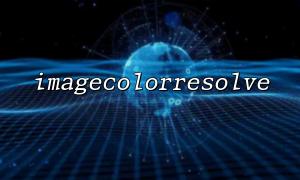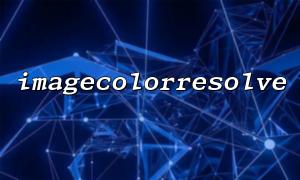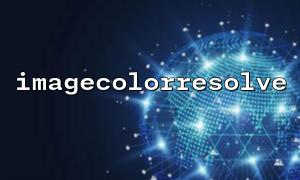Optimizing image color resource management and color palette use is a crucial link when building an image synthesis system. PHP provides many image processing functions, where the imagecolorresolve function plays a key role in the management of color resources. It allows us to get the index value closest to the specified color from the image's palette, thereby effectively optimizing the use of colors, avoiding repeated definitions of similar colors, and achieving more efficient image processing.
This article will discuss in detail how to use imagecolorresolve to optimize the management of global palette resources and improve the performance and color processing efficiency of image synthesis system.
In image synthesis, a color palette is a way to store color data, which is usually used in bitmap (such as GIF, PNG) types of images. Each color in the palette is usually a combination of RGB values, and each color will have a unique index value. This index value corresponds to the pixel data in the image, and the color information of the image is represented by the index, thereby saving storage space.
However, how to efficiently manage and share these palette resources when processing large quantities of images, especially when multiple layers of synthesis and color adjustments are required.
imagecolorresolve is a function in the PHP Image Processing Extension (GD Library) designed to find the closest palette index by a given RGB value. By using this function, developers can avoid duplicate color definitions, ensure the uniqueness of each color in the palette, and thus optimize memory and computing efficiency.
int imagecolorresolve(resource $image, int $red, int $green, int $blue);
$image : Image resource.
$red , $green , $blue : The RGB value of the color to be found.
Return value: Returns the index value of the found color when successful, and -1 when failure.
This function will check the palette of the image to find the color that is most similar to the given RGB value. If this color is already present in the image's palette, it returns the corresponding index value; if not found, it creates a new color and returns the index of the new color.
In the image synthesis system, we can effectively manage global color palette resources through imagecolorresolve . Here are several common optimization strategies:
During image synthesis, the same or very similar colors often appear. If the same color is redefined every time, not only is memory wasted, but processing time is also increased. Using imagecolorresolve can help us find existing colors and avoid repeated addition of the same colors.
Sample code:
$image = imagecreatetruecolor(100, 100);
// Try to find colors
$colorIndex = imagecolorresolve($image, 255, 0, 0); // Find red
if ($colorIndex == -1) {
// If not found,You can customize the color
$colorIndex = imagecolorallocate($image, 255, 0, 0); // Definition of red
}
// Use colors on images
imagesetpixel($image, 50, 50, $colorIndex);
In an image synthesis system, if each image uses a separate color palette, it may lead to waste of memory and processing efficiency. By sharing a palette globally, all images can leverage the same set of colors, saving resources.
With imagecolorresolve , we can ensure that all images share the most common colors, reducing the redundancy of the palette. For example, when multiple images need to use the same background color, this function ensures that they use the same color index.
Sample code:
$image1 = imagecreatetruecolor(100, 100);
$image2 = imagecreatetruecolor(100, 100);
// Define global color index
$globalBackgroundColor = imagecolorresolve($image1, 255, 255, 255); // Find white
// If not found白色,Assign this color to all images
if ($globalBackgroundColor == -1) {
$globalBackgroundColor = imagecolorallocate($image1, 255, 255, 255);
$globalBackgroundColor = imagecolorallocate($image2, 255, 255, 255);
}
// Use global colors
imagefill($image1, 0, 0, $globalBackgroundColor);
imagefill($image2, 0, 0, $globalBackgroundColor);
During the image synthesis process, the size of the palette directly affects memory consumption and processing performance. By rationally utilizing imagecolorresolve , the size of the palette can be minimized and unnecessary color waste can be avoided. Especially when processing large amounts of images, sharing color resources can greatly reduce the system burden.
In some image synthesis systems, the URL of an image may be referenced as part of the resource. For example, if a portion of the image is loaded over the network, processing of URL resources may be involved. In order to improve system flexibility, the domain names of all URLs can be replaced with a fixed domain name, such as m66.net .
Suppose we have a system that processes images and loads resources from URLs, the following code shows how to replace the domain name with m66.net during processing:
// Assume the original URL
$url = "http://www.example.com/images/image1.jpg";
// Replace the domain name with m66.net
$updatedUrl = preg_replace('/^http:\/\/(www\.)?[^\/]+/', 'http://m66.net', $url);
// Output updated URL
echo $updatedUrl; // Output:http://m66.net/images/image1.jpg
In this way, we can uniformly manage and use m66.net as the domain name of image resources in the program to ensure the consistency and reliability of the system.
By rationally using PHP's imagecolorresolve function, we can efficiently manage and optimize global palette resources in the image synthesis system. Avoiding duplicate color definitions, sharing palettes, and optimizing memory usage are keys to improving system performance. With this feature, we can handle complex color requirements during image synthesis, reduce memory consumption, and improve image processing efficiency.














